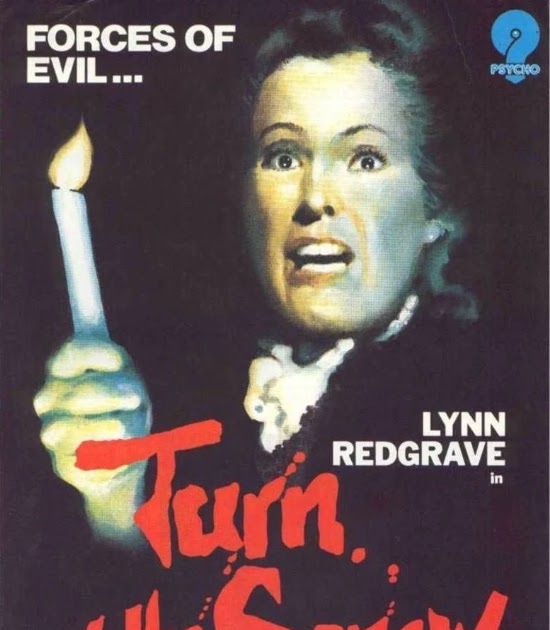The Turn of the Screw is a 1974 TV-movie adaptation of the famous Henry James ghost story. The original novella was published in 1898. The Turn of the Screw was produced and directed by Dan Curtis and scripted by William F. Nolan. It originally aired on the American ABC network. It was one of a series of TV-movies he made around that time based on gothic horror classics.
Miss Jane Cubberly (Lynn Redgrave) has accepted the position of governess at Bly House in Essex. She will be in charge of the household which includes nine-year-old Flora (Eva Griffith) and fourteen-year-old Miles (Jasper Jacob). They are orphans. Their uncle and guardian, Mr Fredricks (John Barron), is perfectly prepared to accept the costs of their upbringing but he has no interest in children and wants to have as little to do with them as possible. He expects Miss Cubberly to assume the entire responsibility for the children and the household.
Bly House seems at first to be a spacious, airy, cheerful house and the children seem likeable and rather charming.
On her first day there Miss Cubberly thinks she sees a man standing in the grounds but no-one else sees him and when she looks again there is nobody there. She decides that she is probably over-tired from her journey.
One things that seems a little odd is that the children are forbidden to mention the previous governess, Miss Jessel. All that Miss Cubberly knows is that Miss Jessel is now dead.
Nobody wants to talk about Peter Quint either. He had been in charge at Bly House until his own death a few months earlier.
Several things make Miss Cubberly uneasy. She hears stories about Peter Quint. It seems that he was regarded as an unsavoury character. She finds some letters that make it plain that Peter Quint and Miss Jessel were having a sexual relationship. Miss Cubberly is horrified. It is obvious to her that Miss Jessel must have been a wicked evil woman.
Miss Cubberly is convinced that she has seen both Peter Quint and Miss Jessel in various places in the house and in the grounds.
She is certain that Peter Quint and Miss Jessel were evil influences on the children and that they are still exerting a demonic influence from beyond the grave. She feels that the children are in extreme danger from the powers of evil.
She is also rather disturbed by the behaviour of Miles.
The reason that the Henry James novella is regarded so highly is that it’s a somewhat ambiguous ghost story and it can be, and has been, interpreted in various ways. A successful adaptation of the novella has to maintain a certain level of ambiguity for as long as possible. We have to be unsure whether Miss Cubberly has actually seen ghosts or whether it is all the product of her overheated imagination. Of course when adapting the story the screenwriter might choose to resolve the story in different ways, either strongly suggesting a supernatural explanation or suggesting that it really is all in Miss Cubberly’s imagination.
This adaptation maintains the ambiguity fairly effectively. We know that Peter Quint was an unpleasant man who may well have been a bad influence on Miles. We know that Quint and Miss Jessel had a sexual relationship. We know that Miles is rather odd, and that he seems to be inclined to be cruel. But Miss Cubberly is the only one who sees ghosts.
The idea that it’s her overactive imagination is certainly very plausible. Miss Cubberly is clearly horrified by any thought of sex, but at the same time the stories about Peter Quint seem to have unlocked her repressed erotic longings. She has erotic dreams about him.
And she is perhaps out of her depth with Miles, who at times seems a bit more grown-up than he should be. It’s as if he’s fourteen going on thirty. He seems perhaps a bit too aware of Miss Cubberly’s womanliness. Of course this could be because he is possessed by the spirit of a grown man, Peter Quint. That’s assuming that he really is possessed, which is by no means certain.
This version has a very TV-movie look, which was obviously unavoidable. It was shot on videotape in Britain, using a multiple-camera setup.
 |
The lack of real visual flair does have the effect of putting the focus on the performances. Lynn Redgrave is superb. She conveys the fact that Miss Cubberly is becoming more and more unhinged but manages to convince us that this could be explained by her own psycho-sexual problems or by the fact that she really is up against the supernatural. Jasper Jacob is extraordinarily unsettling as Miles. Everything about the relationship between Miss Cubberly and Miles is unsettling.
The Dan Curtis Macabre Collection includes this movie and three other gothic TV-movies produced by Dan Curtis in the late 60s and 70s (not all of which he directed himself). The transfer is OK considering that it’s a TV-movie. The only extra for The Turn of the Screw is a mini-doco which includes interviews with Dan Curtis and Lynn Redgrave. I must say I was surprised by Curtis’s explanation of his ending. It’s not at all the way I interpreted it.
This is a reasonably effective adaptation and a fairly decent low-key gothic horror movie. Compared to the novella it doesn’t quite manage to achieve the same level of truly disturbing ambiguity. Recommended.
I’ve also reviewed Curtis’s TV-movie version of The Strange Case of Dr. Jekyll and Mr. Hyde (1968).



